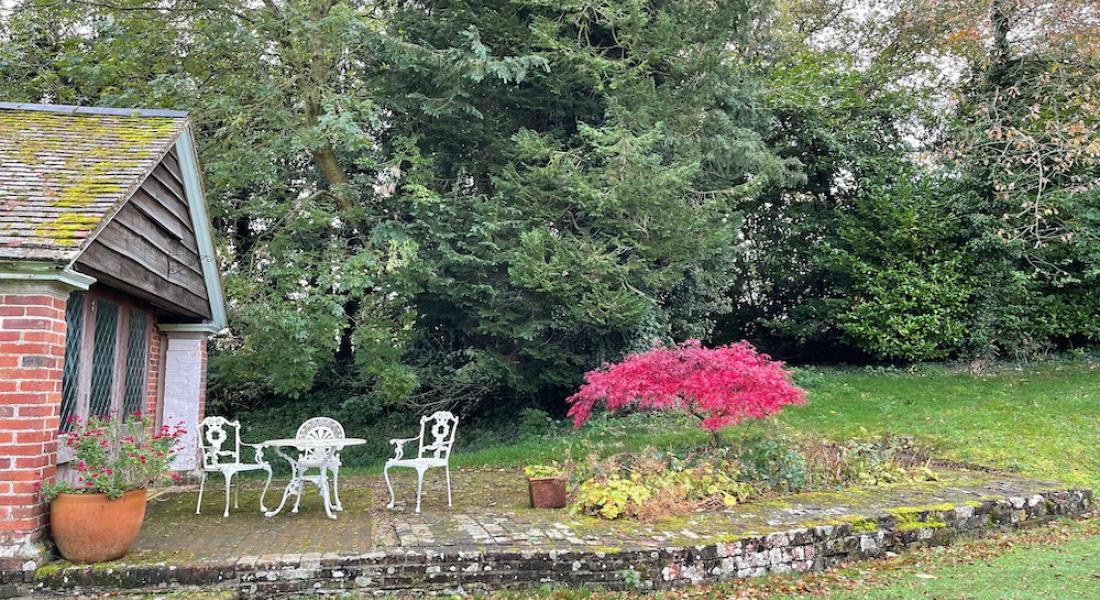As summer ends and autumn's crisp chill comes, it's time to get our UK gardens ready for the cold months. We'll share our top 8 tips to keep your garden looking great through autumn and winter. From cleaning up garden beds to protecting delicate plants and getting your lawn ready, these steps will make your outdoor space shine.
In this article:
- Tidy Up Your Garden Beds
- Protect Tender Plants and Shrubs
- Prepare Your Lawn for Autumn
- Plant Autumn and Winter-Flowering Bulbs
- Compost Autumn Leaves and Garden Waste
- Bring Tender Potted Plants Indoors
- Clean and Store Garden Tools and Furniture
- Prune Fruit Trees and Bushes
Key Takeaways:
- Tidy up garden beds by removing dead plants and debris
- Prune overgrown shrubs and perennials to maintain shape
- Protect tender plants and shrubs from the colder weather
- Aerate and reseed bare patches on your lawn
- Plant autumn and winter-flowering bulbs for a splash of colour
1. Tidy Up Your Garden Beds
As autumn comes closer, it's time to focus on your garden beds. Start by removing dead plants, fallen leaves, and debris. This keeps air moving and stops diseases from spreading, keeping your garden healthy and bright.
Remove Dead Plants and Debris:
Walk through your garden and find any dead plants. Carefully take them out, along with any fallen leaves or organic matter. Make sure to get rid of the debris right, either by composting it or putting it in your local green waste bin.
Prune Overgrown Shrubs and Perennials:
While you're at it, prune any shrubs and perennials that are getting too big. This keeps them looking good and helps them grow new in spring. Use sharp, clean shears and cut just above a bud or leaf node.
| Task | Benefits |
|---|---|
| Clearing dead plants and debris | Improved air circulation, reduced disease spread |
| Pruning overgrown shrubs and perennials | Maintain shape, encourage new growth |
"A well-tended garden bed is the foundation for a thriving and beautiful outdoor space."
By tidying up your garden beds, you're getting ready for a great autumn and winter. A bit of effort now means your garden will stay healthy and look good even in the cold months.
2. Protect Tender Plants and Shrubs
As autumn comes to the UK, we must protect our tender plants and shrubs from the cold. By acting early, we can help them survive and grow well in spring.
First, find out which plants in your garden are vulnerable. Tender plants can't handle frost or cold for a long time. These include delicate annuals, tropical plants, or new perennials. Tender shrubs also need special care to make it through winter.
- Cover tender plants with horticultural fleece or put them in a greenhouse or cold frame to keep them safe.
- Wrap tender shrubs with straw, burlap, or tree wraps to protect them from frost.
- Put mulch around tender plants and shrubs to keep the soil warm and stop the roots from freezing.
By doing these things, we can protect tender plants and protect tender shrubs in our gardens. This ensures they survive and come back healthy next year. It's important to know and meet the needs of each plant or shrub in your garden.
| Tender Plant | Protection Method |
|---|---|
| Dahlias | Lift tubers and store in a cool, dry place |
| Fuchsias | Move potted plants to a frost-free greenhouse or shed |
| Begonias | Lift tubers and store in a cool, dry place |
| Tender Succulents | Move potted plants to a sheltered location or greenhouse |
3. Prepare Your Lawn for Autumn
As summer ends, it's time to get our lawns ready for autumn. A lush, healthy lawn boosts our garden's look. With a few easy steps, we can keep our grass in top shape through autumn and winter.
Aerate and Reseed Bare Patches:
Start by aerating the soil to help with drainage and air flow. You can use a garden fork or a lawn aerator for this. It helps reduce soil compaction and lets nutrients reach the roots better.
After aerating, reseed any bare or thin spots. This keeps your lawn looking full and healthy.
Apply a Final Fertiliser Treatment:
Give your grass a final feed before autumn to help it through the cold months. Choose a slow-release fertiliser that gives steady nutrients. This helps the grass grow strong and survive winter better.
| Task | Timing | Benefits |
|---|---|---|
| Aerate Lawn | Early Autumn | Improves drainage, air circulation, and nutrient uptake |
| Reseed Bare Patches | Early to Mid Autumn | Ensures a consistent, lush lawn appearance |
| Apply Final Fertiliser | Late Autumn | Nourishes grass, helps it prepare for winter |
By aerating, reseeding, and fertilising our lawns for autumn, we keep our gardens looking great. A bit of effort now means a lush, healthy lawn for everyone to admire.
4. Plant Autumn and Winter-Flowering Bulbs
As summer fades, the cooler autumn weather is ideal for planting bulbs. These will add colour to your garden in the cold months. Daffodils, tulips, crocuses, and snowdrops are great choices to keep your garden lively all year.
Here are some tips for planting autumn bulbs:
- Choose a sunny spot in your garden with well-drained soil.
- Plant the bulbs at the recommended depth, typically two to three times the height of the bulb.
- Space the bulbs apart according to their mature size, allowing enough room for them to spread.
- Water the bulbs after planting and continue to water them during dry spells until they become established.
For planting winter bulbs, the steps are similar but the timing is different. Plant winter bulbs like snowdrops and winter aconites in late summer or early autumn. This gives them enough time to root before the ground freezes.
| Autumn Flowering Bulbs | Winter Flowering Bulbs |
|---|---|
|
|
Adding both autumn and winter-flowering bulbs to your garden means you'll have a colourful display all through the cold seasons.
5. Compost Autumn Leaves and Garden Waste
As the cooler months come, it's a great time to start collecting and composting your autumn leaves and garden waste. This stuff is full of nutrients and can be a big help to your garden. It adds essential organic matter that makes your plants grow better.
Composting your autumn leaves and garden waste is easy and really helps your garden. It cuts down on waste and makes a soil amendment that's full of nutrients. This can make your garden beds better in structure and fertility.
- Collect fallen leaves from around your property and add them to your compost bin or pile.
- Include any other garden waste, such as pruned plant material, vegetable scraps, and grass clippings.
- Ensure the compost pile has a good balance of green (nitrogen-rich) and brown (carbon-rich) materials for optimal decomposition.
- Regularly turn and aerate the compost to promote airflow and accelerate the decomposition process.
- In a few months, you'll have a rich, earthy compost that can be incorporated into your garden beds, providing a natural and sustainable way to nourish your plants.
Composting your compost autumn leaves and compost garden waste is a simple yet impactful way to get your garden ready for the colder months. By recycling these organic materials, you'll not only reduce waste but also create a valuable soil amendment. This can help your plants thrive for seasons to come.
6. Bring Tender Potted Plants Indoors
As winter comes, we must look after our tender potted plants. These include citrus trees and tropical plants that need special care to stay healthy. By moving them inside, we protect them from harsh weather and help them keep growing.
To get your plants ready for indoors, follow these steps:
- Check the plants for pests or diseases and treat them before moving inside.
- Trim off any dead or sick leaves to encourage new growth.
- Make sure the soil is damp but not too wet, as indoor air can be drier.
- Find a spot indoors with plenty of sunlight or a warm corner for your plants.
- Use a humidifier or spray the plants with water to keep the air moist.
- Watch the plants closely and change their care as needed to keep them safe through winter.
By doing these things and creating a good indoor space, we can keep our tender potted plants happy and healthy all winter.
7. Clean and Store Garden Tools and Furniture
As summer's vibrant greens fade and autumn's crisp air settles, it's time to prepare our outdoor spaces for winter. Cleaning and storing our garden tools and furniture is key. This ensures they're ready for spring.
First, let's look at our garden tools. Keeping them clean and maintained can make them last longer. Start by removing dirt, debris, or rust. Use a wire brush or damp cloth for stubborn grime, then oil the tools to protect the metal.
- Thoroughly clean all garden tools
- Remove any dirt, debris or rust
- Wipe down with a rust-preventative oil
Next, focus on our outdoor furniture. Clean each piece with mild soap and water to remove dirt or stains. Pay extra attention to areas with mildew or mould. After cleaning, store it in a dry place, like a shed or garage, to protect it from damage.
| Tool | Cleaning Steps | Storage Recommendations |
|---|---|---|
| Secateurs |
| Store in a dry, protected area |
| Spades |
| Hang or store upright to prevent warping |
| Outdoor Furniture |
| Store in a dry, protected area |
Cleaning and storing our garden tools and furniture properly keeps them in great shape for future seasons. With a bit of care, our outdoor spaces will be ready to bloom in spring.
As the seasons change, it's time to prepare our gardens for the colder months. Autumn is key for gardeners, ensuring a garden that thrives in spring. Here are top tips to get your garden ready for autumn in the UK.
Revitalise Your Lawn:
Autumn is great for your lawn. Start by aerating the soil to improve drainage and oxygen flow. This helps your grass roots grow strong, even when it gets colder. Also, a final fertiliser treatment will feed your lawn, preparing it for a lush look next year.
Plant Autumn Bulbs:
Don't let your garden sleep in the cold months. Plant autumn and winter bulbs like daffodils, tulips, and crocuses. They'll bring colour and life to your garden, brightening the winter days.
Compost Autumn Leaves:
Don't waste the fallen leaves. Add them to your compost pile. This mix will break down, giving you rich organic matter for your soil next year.
| Task | Importance | Timing |
|---|---|---|
| Aerating the lawn | Improves drainage and oxygen circulation | Early to mid-autumn |
| Applying a final fertiliser treatment | Nourishes the lawn for a healthy spring comeback | Late autumn |
| Planting autumn bulbs | Adds colour and life to the garden during the colder months | Early to mid-autumn |
| Composting autumn leaves | Provides nutrient-rich organic matter for the soil | As leaves fall throughout autumn |
Follow these steps to keep your plant garden, home garden, and autumn lawn care in great shape. A bit of prep now means a garden that flourishes in spring.
8. Prune Fruit Trees and Bushes
As autumn comes, it's a great time to prune your fruit trees and bushes. Pruning is key to keeping them healthy and productive. By using the right techniques, your apple, pear, and blackberry plants will do well.
Proper Pruning Techniques:
Pruning needs care and an eye for detail. Here are some important tips:
- Timing is key: Prune in late winter or early spring when they sleep. This reduces disease risk and helps new growth.
- Focus on shaping: Prune to keep the plant's shape right. Remove branches that cross, rub, or are damaged.
- Thin out the centre: Remove some branches inside to improve air flow and light. This can boost fruit production.
- Cut at the right angle: Cut just above an outward bud or branch. This helps with healthy growth.
- Disinfect your tools: Keep pruning tools clean and disinfected to stop disease spread.
By using these pruning techniques, you can make sure your prune fruit trees and prune fruit bushes flourish. They will give you a big harvest in the future.
Conclusion
By following these 8 top tips, we can make our UK gardens ready for autumn. This means our gardens will stay beautiful and enjoyable, even in the cold months. It's important to do each task on time to get our gardens ready for autumn and winter.
Getting our gardens ready for autumn and winter is key. We need to tidy up, protect plants, and prepare our lawns. We should also plant bulbs for autumn and winter, compost leaves, and store our garden tools. These steps will help us keep our gardens looking great through the tough weather.
By using these garden preparation, autumn garden tips, and UK garden care tips, we can enjoy a beautiful garden all year. Our outdoor space will stay lovely and give us joy and relaxation, even when it's cold and dark.
FAQ
What is the best way to tidy up our garden beds?
Start by clearing your garden beds of dead plants, fallen leaves, and debris. This improves air circulation and stops disease spread. Also, prune overgrown shrubs and perennials to keep their shape and encourage new growth in spring.
How can we protect our tender plants and shrubs from the cold weather?
Find tender plants or shrubs that need extra cold weather protection. Cover them with horticultural fleece or move them to a sheltered spot. This ensures they survive the winter.
What steps should we take to prepare our lawn for autumn?
Keep your lawn healthy for your garden's look. Begin by aerating the soil for better drainage and air flow. Then, reseed bare spots. Finally, give a final fertiliser to feed the grass through autumn and winter.
Which autumn and winter-flowering bulbs should we plant?
Use the cool autumn weather to plant bulbs for colder months. Include daffodils, tulips, crocuses, and snowdrops. They'll brighten your garden when it's quiet.
How can we compost our autumn leaves and garden waste?
Collect fallen leaves and add them to your compost bin. This material is rich in nutrients. Use it to enrich your garden beds, helping your plants grow strong.
What should we do with our tender potted plants?
Bring tender potted plants, like citrus trees or tropical species, inside before the first frost. This keeps them safe from the cold and lets them thrive through winter.
How should we clean and store our garden tools and furniture?
Clean and maintain your garden tools, like secateurs and spades, before storing them. This makes them last longer and be ready for spring. Clean your outdoor furniture well and store it in a dry place to avoid damage.
What are the best practices for pruning our fruit trees and bushes?
Autumn is great for pruning fruit trees and bushes, like apple and blackberry plants. It keeps their shape, boosts growth, and increases fruit yield. Always prune correctly to avoid harming the plants.



